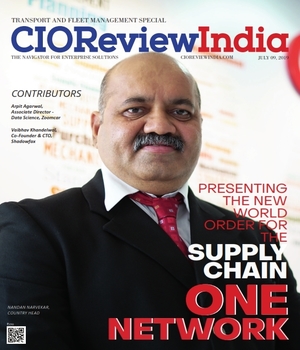
Innovation in Business
Praney Malhotra , Head - Strategic Sourcing & Planning, Arvind Lifestyle | Wednesday, 19 July 2017, 11:43 IST
 To understand innovation, we should first see how the word is defined. Wikipedia says that innovation can be defined simply as a “new idea, device, or method”. However, innovation is often also viewed as the application of better solutions that meet new requirements, unarticulated needs, or existing market needs.
To understand innovation, we should first see how the word is defined. Wikipedia says that innovation can be defined simply as a “new idea, device, or method”. However, innovation is often also viewed as the application of better solutions that meet new requirements, unarticulated needs, or existing market needs.
Steve Jobs maintained that customers don’t know what they want. He believed that he and his company Apple could create exceptional products which would be considered innovative and would be widely accepted by customers. Typically, Apple is known for offering very few variants in each of their product lines as compared to their competitors – this stems from their inherent belief that customers do not want their already complicated lives to be further complicated by having to ‘choose’ from too many options.
So in the context of business environment, innovation is anything which is
1. TRANSFORMATIVE
2. RELEVANT
3. Can be MONETISED
Can We Rationally Arrive at an Innovation?
Not really! Innovation evolves from an/some idea(s) – which may come from anyone or anywhere. Hence, organizations that create structures or teams to work only on innovation not only narrow the scope of innovation but also limit themselves because:
1. Structured teams only focus on given tasks and are bound by objective deliverables and hence become predictable.
2. The rest of the company feels that they are not responsible for new ideas and innovation and that it is some other team’s job.
How does then one create, an organization where innovation is in the DNA? Before we answer this question we must look at another issue which ails the innovation process in organizations.
What Is Behind the Rise of Mediocrity?
Why there are few exceptional creators/innovators in today’s world like Steve Jobs, Elon Musk? To understand this, we should look at the genesis of organizational growth in the last 50 or 60 years and also some trends which have changed the way in which society looks at new products, services or even art.
1. The Rise of the Critic: for every product launch the general public looks at what some of the critics are saying. What gives these critics the right to comment on anything? Can they create or design great products of their own? We all seem to enjoy this new trend of being judgmental and critical about everyone or everything; thus scaring the innovators from even attempting because of the fear of criticism.
2. The Rise of the Coordinator: Whether in agencies or in lifestyle fashion the innovators do not go on to either receive higher remuneration or the top job in companies. It is either the client servicing person or the merchandising person who eventually goes on to get a shot at the top slots in the company. What does this bode for the innovators? While some of the top companies in these industries have stated bucking the trend – most other players have still not caught on to this fact.
3. The Rise of the Analyst: For some strange reason a lot of companies today look towards analysts for answers. Hence, in many companies, consultants define the strategy – Where is the role of the innovator in strategy making
4. The Rise of the Manager as Against the Rise of the Innovator as the Leader
Do the above not look familiar? Isn’t this what happened to Steve Jobs and Apple.
Let’s go back to answer the question we raised earlier - How does then one create, an organization where innovation is in the DNA?
A ‘CREATE A CULTURE’ encouraging innovation – simple answer, but is it easy to do? How does one do that?
1. Give innovators a say in strategy formation
2. ‘Celebrate attempt’ – by rewarding and encouraging those who attempt over those who analyze and critique
3. Recognize internal resistance (insecurities of certain teams) and address it upfront
4. Put their money where their mouth is or in other words spend on inspiring people to innovate.
And finally the most important point – ALLOW FAILURE – particularly if the intent is to innovate or do things differently. Innovation by definition entails taking risk and hence could lead to numerous failures. But a company willing to build innovation as a DNA must be willing to allow for failure.
How can Procurement Teams Support In Innovation?
Most companies have two functions which are outside facing - Sales and Procurement. To answer the above question some of the key initiatives which a procurement team should do are:
1. Create platforms for collaboration on innovation (with vendors and innovators)
2. Set mutually beneficial targets on projects that encourage innovation
3. Incentivize innovation from vendor partners. This could also mean encouraging vendor partners in R&D
4. Set up a separate vertical within the procurement team that focuses on innovation and R&D Innovation takes courage. It means change. It means daring to do new things and hence, risking failure. This goes against the very grain of the intelligently managed organization. Yet it is the very essence of sustaining and growing market share in a world that is changing very fast.
CIO Viewpoint
Adoption Of New Technology Trends In The...
By Vinod Raju, Head IT & Enterprise Applications, EFL (Expo Freight)
Vehicle Tracking Bringing Transparency In...
By Biren Parikh, CIO, CERA Sanitaryware Ltd
B2B Integration Key to Supply Chain Excellence
By Dan Sellers, CIO, WSI
CXO Insights
Kroks Technologies LLP Delivering Tracking,...
By Ashith Kunder and Ashwin Kunder, Co-Founders
Technology Pushing Cost Savings in Logistics
By E.R. Williams, Co-Founder & Technology Lead, Zipline Logistics
Technology: Building a Competitive Advantage in...








